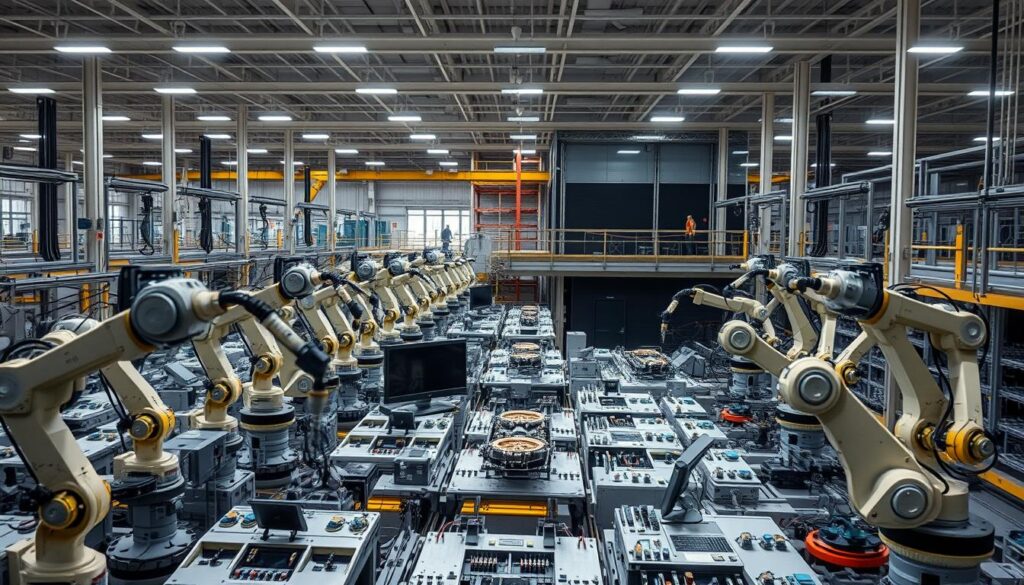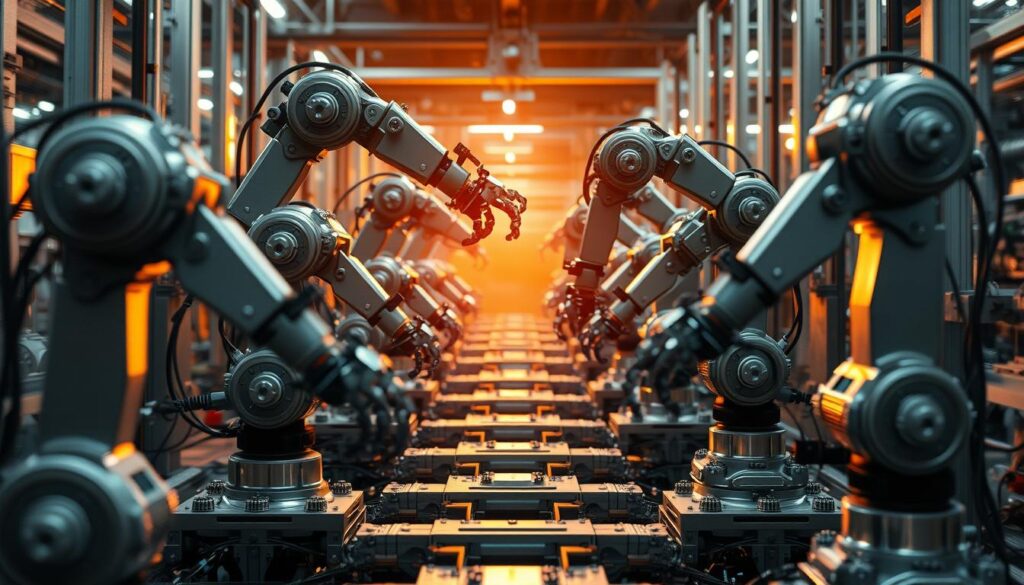The world of industrial robotics is changing fast. New robotic solutions are making manufacturing more flexible than ever. These changes are big for how companies tackle production problems.
Modular robotic arms are leading the way in making manufacturing more adaptable. They let businesses quickly adjust to new market needs. These systems are way more flexible than old fixed automation.
The global robotics market is expected to hit $192 billion by 2033. This shows a big move towards smart, flexible manufacturing. Companies need robotic solutions to stay ahead and keep production running smoothly.
Using modular robotic systems, companies can quickly change their production lines. This cuts down on downtime and makes operations more agile. These new technologies make it easy to adjust to changing market needs and what customers want.
Adding modular robotic arms to manufacturing lets companies create smarter, more flexible production systems. These systems can grow and change without much trouble to the current workflow.
Understanding Modular Robotics in Manufacturing
Advanced manufacturing technology is changing how we make things. Modular robotic systems are leading this change. They make production more flexible and adaptable.
Today, manufacturers are using modular robots to solve tough production problems. These smart systems work well in many industries.
Core Components of Modular Robotic Systems
Modular robotic arms have key parts for smooth work:
- Interchangeable end-effectors
- Quick-connect interfaces
- Adaptive programming modules
- Standardized communication protocols
Benefits of Modular Design Architecture
The modular design brings big benefits to making things:
| Benefit | Impact |
|---|---|
| Increased Flexibility | Rapid task reconfiguration |
| Cost Efficiency | Reduced equipment replacement expenses |
| Scalability | Easy system expansion |
Integration with Existing Production Lines
Integrating robots with current lines is easy. Plug-and-play features make changes simple. This way, production can quickly adjust to new needs.
Using advanced tech, companies can make their production faster and more flexible. This helps them meet changing market needs better.
Industrial Robotics Development: Current Trends and Applications

The world of industrial automation is changing fast with new autonomous robotic systems. Today’s factories use smart robots that can learn and do complex tasks with great accuracy.
Important changes in robotics are making production better in many areas:
- AI-powered robots with advanced object recognition
- Intelligent navigation systems
- Real-time data processing capabilities
- Enhanced machine learning algorithms
The car, electronics, and logistics fields are seeing big changes. Autonomous robotic systems are now doing tasks that people used to do. Warehouses use these systems to find and handle items with amazing accuracy, cutting down on mistakes.
The use of Industry 4.0 ideas has made industrial automation more popular. Now, robotic systems can talk to each other, check themselves, and get better in real-time. This big step forward lets makers work faster and keep quality high.
New trends show that future robots will be even smarter and more flexible. They will keep improving the mix of human creativity and machine precision. This will open up new chances for making things better in factories.
Enhancing Manufacturing Flexibility Through Modularity
Modern manufacturing needs to be very adaptable. Robotic programming services are changing this by introducing modular systems. These systems are making manufacturing more flexible and efficient.
More and more manufacturers see the big benefits of modular robotic systems. A robotics engineering firm can now create solutions that greatly improve production capabilities.
Quick-Change End Effectors and Tools
Modular robotic arms have new end effector technologies. These technologies allow for fast changes in tasks. This means manufacturers can:
- Swap tools in seconds
- Reduce time to change equipment
- Lessen interruptions in production
Adaptive Programming Solutions
Advanced robotic programming services offer top-notch software. This software makes it easy to reprogram robots. Manufacturers can now:
- Change robot functions quickly
- Create unique workflow algorithms
- Use machine learning
Scalable Production Capabilities
Modular robotic systems are very scalable. They have flexible designs that let manufacturers adjust production easily. This is based on what the market demands.
The future of manufacturing is about adaptable, smart robotic solutions. These solutions can change production environments quickly and precisely.
Impact of Modular Robots on Production Efficiency

Modular robots are changing how we make things in factories. They bring new flexibility and precision to the work. This is a big step forward in making things better and faster.
Thanks to these robots, factories are working better than ever. They see big wins like:
- Less time stopped for repairs
- Better checks for quality
- More stuff made in less time
- Using resources more wisely
Numbers show how much these robots help factories work better. Here are some key improvements:
| Efficiency Metric | Improvement Percentage |
|---|---|
| Production Speed | 35-45% |
| Error Reduction | 25-30% |
| Maintenance Costs | 20-25% Decrease |
Using modular robots smartly changes how factories work. By adding smart automation, companies can make their factories more flexible. This lets them quickly meet new market needs.
These robots help factories make things more smoothly and with less mistakes. They are a smart choice for keeping factories ahead in the future.
Future-Proofing Manufacturing with Modular Systems
The world of industrial robotics is changing fast, leading to new advancements in making things. Modular robotic systems are a big step forward. They make manufacturing smarter and more flexible.
Today, makers are using new tech to make production smarter and more flexible. This tech helps create strong systems that can quickly adjust to new needs.
Industry 4.0 Integration
Industry 4.0 is changing how we make things. Modular robots are key to smart factories. They help different parts of production talk to each other easily.
- Real-time performance monitoring
- Interconnected manufacturing systems
- Decentralized decision-making capabilities
AI and Machine Learning Applications
Machine learning is changing robots. It lets them get better over time by learning from data. These smart robots can spot complex patterns and solve new problems.
| Machine Learning Capability | Manufacturing Impact |
|---|---|
| Pattern Recognition | Improved Quality Control |
| Adaptive Programming | Enhanced Production Flexibility |
| Predictive Analytics | Proactive Maintenance Scheduling |
Predictive Maintenance Capabilities
Now, robots can predict when they might break down. They watch how things work and spot signs of trouble. This helps avoid sudden stops in production.
The future of making things is about robots that can learn, predict, and act with great precision.
Conclusion
Modular robotic arms are changing the game in industrial manufacturing. They bring flexibility and efficiency to the table. This means manufacturers can quickly adjust to new market needs, making production more agile.
Adding modular robotic systems to manufacturing is a big deal. Companies that use these solutions can get ahead of the competition. They can cut downtime and boost production, thanks to these systems’ ability to grow or change easily.
Modular robotics will keep getting more important as technology advances. Companies that use these solutions will be ready for future challenges. They’ll be able to work more efficiently and grow sustainably in a complex world.
The future of modular robotic arms looks bright. With improvements in AI and machine learning, these systems will get smarter and more adaptable. They’ll be key to keeping manufacturing competitive in the U.S. and worldwide.

